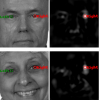Free Online Productivity Tools
i2Speak
i2Symbol
i2OCR
iTex2Img
iWeb2Print
iWeb2Shot
i2Type
iPdf2Split
iPdf2Merge
i2Bopomofo
i2Arabic
i2Style
i2Image
i2PDF
iLatex2Rtf
Sci2ools
CVPR
2009
IEEE
2009
IEEE
Average of Synthetic Exact Filters
This paper introduces a class of correlation filters called
Average of Synthetic Exact Filters (ASEF). For ASEF, the
correlation output is completely specified for each training
image. This is in marked contrast to prior methods such as
Synthetic Discriminant Functions (SDFs) which only specify
a single output value per training image. Advantages of
ASEF training include: insenitivity to over-fitting, greater
flexibility with regard to training images, and more robust
behavior in the presence of structured backgrounds. The
theory and design of ASEF filters is presented using eye
localization on the FERET database as an example task.
ASEF is compared to other popular correlation filters including
SDF, MACE, OTF, and UMACE, and with other eye
localization methods including Gabor Jets and the OpenCV
Cascade Classifier. ASEF is shown to outperform all these
methods, locating the eye to within the radius of the iris approximately
98.5% of the time.
| Added | 09 May 2009 |
| Updated | 10 Dec 2009 |
| Type | Conference |
| Year | 2009 |
| Where | CVPR |
| Authors | Bruce A. Draper, David S. Bolme, J. Ross Beveridge |
Comments (0)

